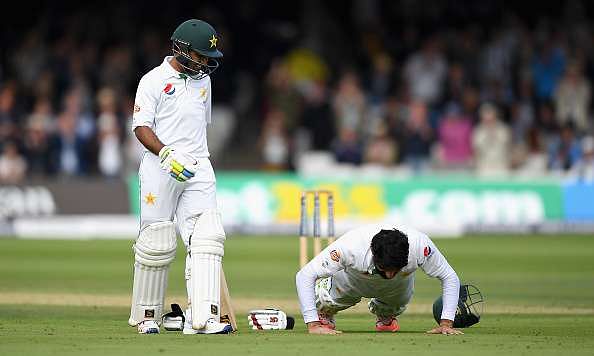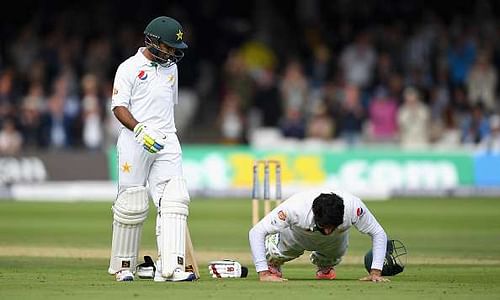
The top Test batsmen after turning 35 - When age is just a number

Misbah-ul-Haq isn’t really supposed to be playing for this long. He wasn’t loved as much as the maverick Shahid Afridi was amongst his countrymen. He doesn’t ignite anyone’s imagination. He doesn’t fire up emotions. He does the opposite. He douses the fire and calms things down. And he goes on. And on. Tuk, tuk.
In his very first innings at Lord’s, the Mecca of Cricket, Misbah scored a century, long after he turned 40 and that too, in the style he does, from perilous positions, when the chips are down. He celebrated in a rather un-Misbah-ic style with 10 push-ups and when Pakistan won the Test, his players gave him a salute imitating the act – the kind of respect you dream of coaxing out of your colleagues.
Also read: Records broken by Misbah-ul-Haq after his century against England
Sport and athletic capabilities are intertwined and athletic capabilities and age are entangled with each other. Some forms of sport, like football, need the players to be fit and agile and an age of 30 could already be a tad too old. Some forms of sport like chess allow players to use their mental faculties more and last way longer than the other physical games. And there are sports like cricket, where athletic capability is needed but at the same time, a player can extend his career through a mix of fitness, mental perception, importance to the team and consistent performances.
Misbah-ul-Haq has been defying age for about half a decade now. Some others have too; most notable being Jack Hobbs, who has scored more first-class runs and first-class centuries than anyone else and holds the record for the oldest man to get a Test century at the age of 40. But, that is hallowed turf and we will not venture there, into that era.
However, we will look at the top 5 batsmen in Test cricket, in terms of contributions made to their teams after turning 35. We will use parameters like runs scored after turning 35, centuries made, minutes played – isn’t it a great test for their stamina - and balls faced.
Very interestingly, it is the same set of batsmen who occupy the top slots when we take a look at their contributions under various parameters. Interestingly, and as the emblem of Misbah’s second wind, he is the only player to play beyond the age of 40 after the 2000s and score in excess of 1000 runs. He has 1335 while Shivnarine Chanderpaul comes a distant second with 453 runs.
Misbah is third on the all-time list of batsmen with most runs after turning 40. Jack Hobbs rules that list with 2440 runs in 27 matches at a phenomenal average of 58.09 with 8 centuries. The Pakistani also has the most half-centuries by any batsman in Test cricket after turning 35 – 32. Graham Gooch comes a distant second with 21 half-centuries.
Misbah’s conversion rate is bad and he has only 8 centuries but that also has a lot to do with his No.5 batting position where he hardly gets a chance to play long innings without pressure.
Runs scored after turning 35
| Tests after turning 35 | Runs Scored | Batting Average | Career Batting Average |
Graham Gooch | 52 | 4563 | 48.54 | 42.58 |
Sachin Tendulkar | 53 | 4139 | 49.86 | 53.78 |
Misbah-ul-Haq | 51 | 3840 | 50.52* | 48.95* |
Geoffrey Boycott | 45 | 3535 | 47.77 | 47.72 |
Rahul Dravid | 47 | 3493 | 45.36 | 52.31 |
*Misbah still has quite a few Tests left in him and he has a genuine opportunity to topple Gooch, who is just 723 runs ahead of him and on the No.1 spot on this list.
Centuries after turning 35
| Tests after turning 35 | 50s | 100s |
Graham Gooch | 52 | 21 | 12 |
Sachin Tendulkar | 53 | 19 | 12 |
Rahul Dravid | 47 | 13 | 12 |
Younis Khan | 27 | 4 | 11 |
Geoffrey Boycott | 45 | 16 | 10 |
Jack Hobbs | 33 | 12 | 10 |
Jacques Kallis | 26 | 5 | 10 |
Steve Waugh | 40 | 8 | 10 |
Of the batsmen in the previous list, only Misbah is missing out but that could be ascribed to the fact that he bats at No.5. Steve Waugh’s record, is therefore, phenomenal here, considering he batted at No.5 too, for the greater part of his career. Younis Khan on this list has the most phenomenal conversion rate, scoring a century every 2.5 Tests (similar to Kallis) and converting 11 out of his 15 fifty-plus scores to triple figures.
Balls faced after turning 35
| Tests after turning 35 | Balls Faced |
Geoffrey Boycott | 45 | 10388 |
Graham Gooch | 52 | 9133 |
Misbah-ul-Haq | 51 | 8410 |
Rahul Dravid | 47 | 7983 |
Sachin Tendulkar | 53 | 7663 |
Shivnarine Chanderpaul | 43 | 7425 |
The list is almost getting repetitive now and that is hardly surprising. The only other batsman who makes it close to ‘the hallowed 5’ at No.6 position is Chanderpaul who could have, if not for the West Indies’ selectors’ ignominious decision-making, gone past a few more batsmen.
Minutes batted after turning 35
| Tests after turning 35 | Minutes Batted |
Geoffrey Boycott | 45 | 13743 |
Graham Gooch | 52 | 12241 |
Misbah-ul-Haq | 51 | 11707 |
Rahul Dravid | 47 | 11356 |
Sachin Tendulkar | 53 | 11153 |
Shivnarine Chanderpaul | 43 | 9606 |
Chanderpaul retains his 6th position in minutes batted in Test cricket, but the top 5 continue to be the same.
Highest averages after 35 (Qualification: 2000 runs)
We decided to look at a few batsmen who never slowed down at 35. These batsmen didn’t make it to the lists above because of early retirements. Yet, it is worthwhile to note who scored at impressive averages, and not to anyone’s surprise, there are some new names on the list.
In all, 25 batsmen have more than 2000 runs in Test cricket after turning 35. And surprisingly, the top four of the five are not batsmen from an era gone by but from contemporary age, which is remarkable when you consider the competition and the fitness levels expected along with the pressures and rigors of modern-day cricket.
| Tests after turning 35 | Runs Scored | Batting Average |
Kumar Sangakkara | 23 | 2528 | 60.19 |
S Chanderpaul | 43 | 3291 | 57.73 |
Younis Khan | 27 | 2638 | 57.34 |
Jacques Kallis | 26 | 2163 | 56.92 |
Jack Hobbs | 33 | 2945 | 56.63 |
While it is easy to say that age is just a number, proving it on a cricketing field, while playing with and against players, who may be more than 20 years younger to you is a daunting task. But a lot of the batsmen mentioned above have managed it with éclat and élan and for that, they truly deserve a standing ovation!